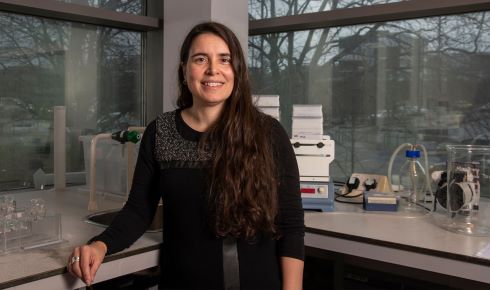My Lab Unlocked: Hypoxia Researcher Professor Sonia Rocha FRSB

Professor Sonia Rocha on the link between oxygen and inflammation
Our team investigates mechanisms controlling gene expression in response to low oxygen and how these interface with inflammation. Oxygen is essential for the vast majority of multicellular organisms, and as such there are extensive and exquisite mechanisms of sensing and responding to alterations to oxygen homeostasis.
We are very proud to be part of the community of researchers that investigates low oxygen sensing. This is a truly collaborative community, where knowledge, training and reagents are shared, from Nobel Prize winners to early career researchers.
We have contributed to this area demonstrating an intrinsic interplay between low oxygen and inflammation, and how the key transcription factors regulate each other. We found novel mechanisms controlling these transcription factors, novel genes associated with this response, and how low oxygen directly impacts on cell cycle and chromatin organisation via the action of molecular oxygen sensors called dioxygenases.
Despite significant advancement in this area, warranting a Nobel Prize and several therapeutics already in human use, several challenges are still in place. We need better tools and to adapt unbiased approaches to this field, something easier said than done.
Big questions remain, such as why the main transcription factors involved have, at times, opposite roles in different tissues. How can an oxygen gradient be formed in tissues and organs without triggering the hypoxia response? How do different organs have different oxygen levels as their normal? How can we use the system to prevent damage in areas of oxygen deprivation in human health but also in plants?
We are an interesting laboratory as we tend to use all possible approaches to solve our questions, from using techniques not used in our field before, to collaborating with experts in other areas to help drive forward knowledge. We have used several omics approaches to answer important questions in our field. We are fully equipped to expose cells and organisms such as the fruit fly to low oxygen, possessing the required hypoxia workstations. Our facilities also have oxygen control in our plate readers and high-end microscopes.
My independent position started in 2005 but really my team was only formed between 2006 and 2007, when a PhD student and a postdoctoral fellow joined. It was an exciting and stressful time, as I was under a tenure track position. Soon the lab expanded with an additional PhD student, a postdoctoral fellow and a research technician.
We all worked together as a team on all the projects. I am very proud of all my students, postdoctoral fellows and research technicians who have gone on to obtain great positions in the areas of industry, medicine and research. Our team has been very international and diverse, with everyone having the same voice and worth.
Also, our discoveries, which are always at the crossroads of two or more research areas, created novel avenues of research and even novel concepts. These included discovering inflammation being a mimic for low oxygen; hypoxia inducing inflammation; and low oxygen and metabolisms controlling cycle and chromatin directly via the action of molecular oxygen sensor belonging to a family of dioxygenases. Furthermore, all of these areas are applied to numerous organisms from plants to humans.
We are always interested in collaborating. Our work and area can be applied to many areas of biology and organisms, from plants to humans. Our best work has been with collaborators, where different expertise come together to be more than the sum of the individual parts.
Our interests are also very broad, from structural analysis, chemical biology and gene regulation, to biosensor engineering, biomarker discovery across human disease and plant physiology. Any of these areas are of great interest to us.
None of what I mentioned could have been achieved without the support of my mentors, colleagues and family, as well as the funders that believed in my ideas over the years. There have been lots of hits and misses, such as our areas is.
I have been supported by the MRC, BBSRC, CRUK, Wellcome Trust and charities such as Tenovus Scotland and Worldwide Cancer Research. I’ve also had great support from the two universities I have spent most of my life in: University of Dundee and University of Liverpool, which are both excellent examples of encouragement and support.
Find out more about the Institute of Systems and Molecular and Integrative Biology
Sonia Rocha FRSB is a Professor of Biochemistry and Executive Dean at the Institute of Systems Molecular and Integrative Biology, University of Liverpool


